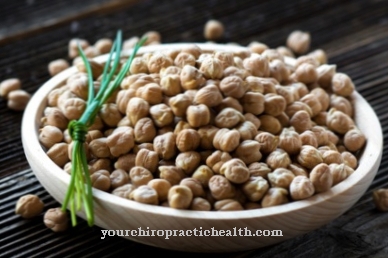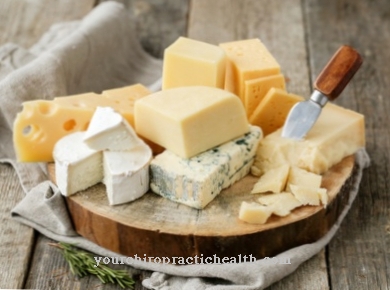As Oysters is called a family of sea clams. Their different genera serve the people on the one hand for pearl cultivation, on the other hand as food. The consumption of oysters is part of the gourmet cuisine in Europe and the USA. They are very nutritious and are considered an aphrodisiac. The most important oyster genus for food purposes is the Pacific rock oyster.
What you should know about oysters

In European gourmet cuisine, the oyster is consumed raw and fresh. The prerequisite is a bowl that is tightly closed until it is consumed. This is where the mussel stores sea water, which it needs to survive. The oyster taste is therefore salty and characterized by the aromas of the sea. Lemon or vinaigrette are typical serving additions and partially neutralize the salt content.
The mussel meat is very high in protein and has a nutty flavor of its own. This comes into its own if the oyster is not swallowed immediately, but instead is chewed a little in the mouth. Oysters can also be boiled, fried, and grilled. A diverse recipe culture has developed in this regard in North America. Oysters are generally cooked in Asian cuisine. She does not attach any gourmet importance to them. Oysters have existed for 250 million years. They have many natural predators. To protect them, they have therefore developed very thick shell flaps. The vulnerable mollusc forms them on the stomach and back. The back flap is flatter than the abdominal flap.
A mechanical joint connects the shell flaps and keeps them slightly open. The mussel has neither a brain nor eyes. 40% of their body mass is made up of muscles. When she tenses her muscles, the shell flaps close airtight and store small amounts of seawater inside. With this technique, oysters can survive for about 14 days on dry surfaces. The muscle strength of the small molluscs is so great that humans cannot open the shells on their own. This can only be achieved through the leverage of a tool - usually an oyster knife. Oysters do not have a shell foot to move about. That is why they stay at the same location throughout their life. They prefer to live in coastal waters and like to live near rivers.
Sea water there contains more nutrients than on the sea floor. Oysters filter 240 liters of water every day and feed on microalgae. Wild oysters have been severely decimated by human consumption and marine pollution. 96% of all oysters eaten come from aquaculture. 93.7% is the Pacific rock oyster. Most of it comes from China. In Europe, this genus of oysters is usually offered as "Fines de Claire". The American oyster accounts for 5.1% of the annual production. The share of European oysters is only 0.2%. They are named after their places of breeding: In France e.g. Bélon, in Great Britain Colchester.
Importance to health
The health effects of the oysters are varied. They have a sleep and appetite stimulating effect. They are extremely low in calories and ideally suited for diet foods. 1 - 2% of the mussel meat is made up of vitamins and minerals. Therefore oysters offer an optimal supply of trace elements.
When consumed raw, these vital substances are fully available to the body's functions. Oysters are high in zinc. This chemical element supports the formation of the male sex hormone testosterone. Therefore oysters are said to have a lust-increasing effect and an increase in erection duration. The oyster shell contains organic sulfur compounds with anti-inflammatory effects. Ground oyster shells are used in empirical medicine to relieve rheumatic diseases and pain.
Ingredients & nutritional values
Oysters consist of 83-86% water, 9-10% protein and 4% carbohydrates. They contain a lot of calcium and magnesium, plus zinc and iron as well as iodine and phosphorus. They supply the body with vitamins A, B1, B2, B12 as well as nicotinamide, folic acid and biotin. 100 g of oyster meat contain approx. 65 - 75 kcal.
Intolerances & allergies
Oysters should only be bought and consumed in locations that are subject to regular food and health checks. There are health risks when eating oysters of unexplained origin. Then there is no guarantee that the oysters do not contain any parasites or harmful bacteria.
Oysters are also problematic if they come from a marine environment with poisonous algae or an algal bloom (so-called red tide). The toxic substances accumulate in the mussel meat. The consumption of such oysters is highly toxic. In order to protect yourself from health risks, it is imperative to pay attention to the proven origin. Eating dead oysters is also highly toxic. The decomposition process releases dangerous shell toxins.
Shopping & kitchen tips
The freshest and best quality oysters are available directly from oyster farmers in coastal regions - for most consumers only accessible during their vacation. In everyday life, fishmongers, supermarkets and internet ordering services are the alternative. If you want to prepare warm dishes and cook or fry the oysters, you can safely opt for frozen oysters.
When buying fresh oysters, it is best to check their condition at the local fishmonger or in the supermarket. Oysters would never open their shells out of the water. Only a dead mussel no longer tenses its muscles and therefore has an open shell. If a mussel with open shell flaps can be discovered in the range, it is better not to buy it at all. This also applies to oysters with broken or damaged shells. It is also important to ensure that the oysters are lying with their rounded belly side down in the display and have not been tossed around wildly.
Sellers should generally be asked when the oysters were fished. A professional trade will be happy to provide information about this at any time out of responsibility for customer health. When ordering online, delivery should be made within 24 hours. The oysters are optimally packaged in styrofoam boxes with ice packs. Best to eat immediately. If necessary, oysters can be stored in the refrigerator for 3 - 4 days at temperatures of 5 - 10 ° C. To do this, layer the oysters in a watertight container - belly down. Place a cloth over it and store it separately from other foods. Before preparation, wash the bowls carefully with a brush under running water.
Preparation tips
To eat raw oysters, the shell must be opened with an oyster knife. This harbors a high risk of injury. Be sure to wrap the top of the shell in a thick towel or put on a special protective glove. Pierce the knife into the shell joint on the back, turn the knife clockwise, then the joint breaks.
Then guide the knife edge directly along the upper shell to separate the upper shell from the oyster muscle. Remove the shell and separate the belly shell from the muscle meat. They can be eaten unseasoned or refined with lemon juice, parsley or onions to taste. The removed oyster meat can be breaded and deep-fried or fried in a pan. They can be cooked or grilled with the bowls. Only mussels should be eaten whose shells open after 5 - 10 minutes and from which (when grilling) the water stored inside foams in fine bubbles from the mussel gap.












.jpg)



.jpg)










.jpg)
